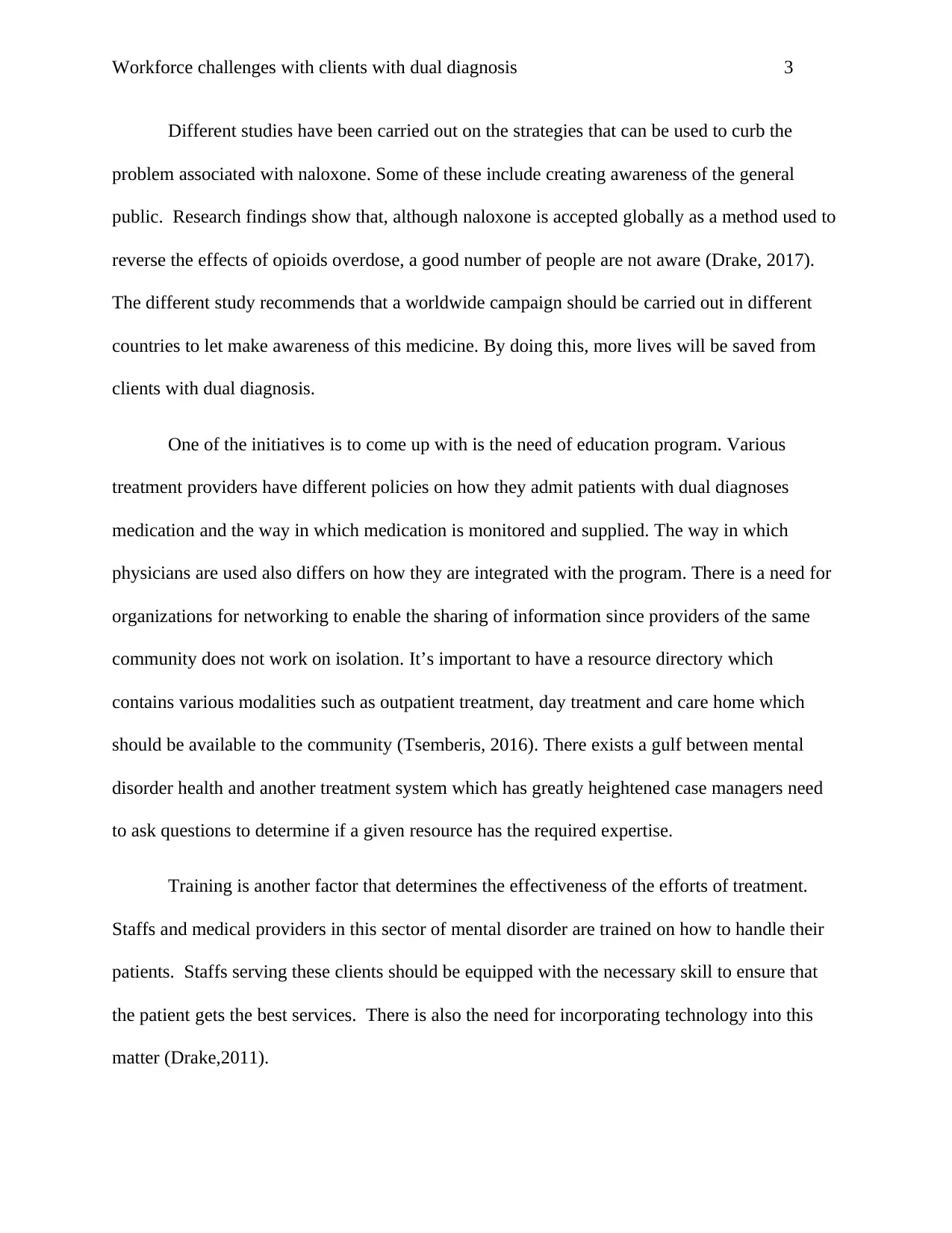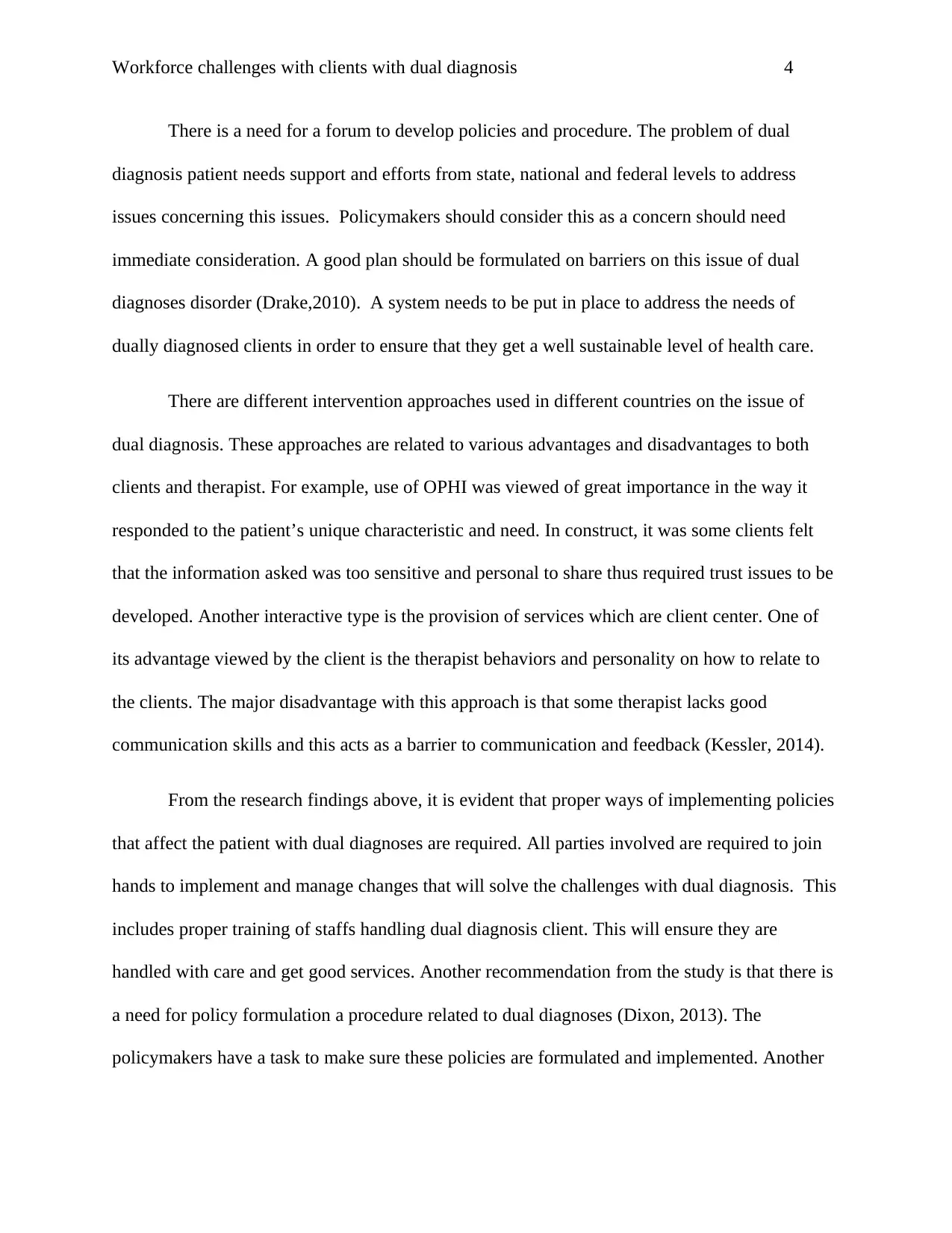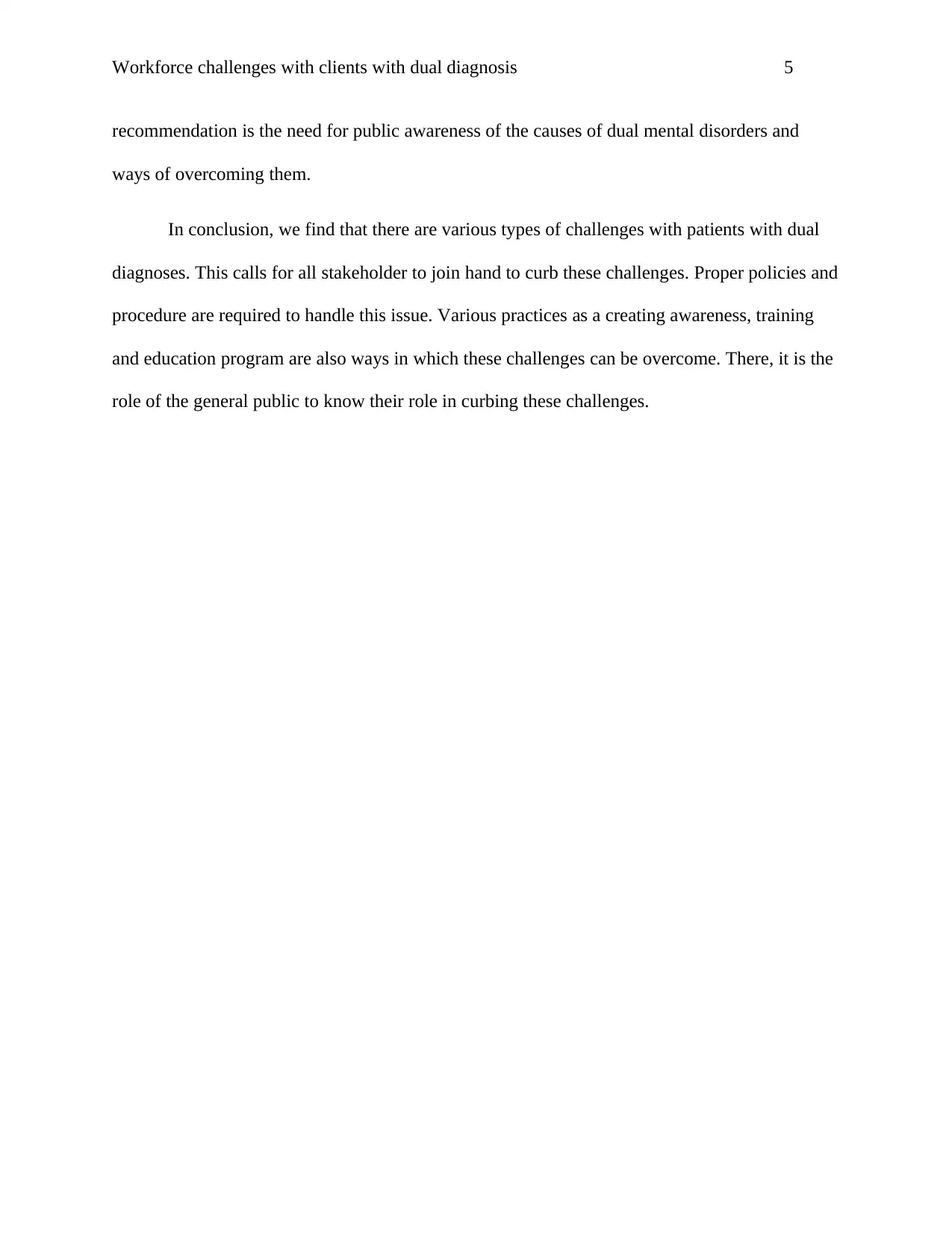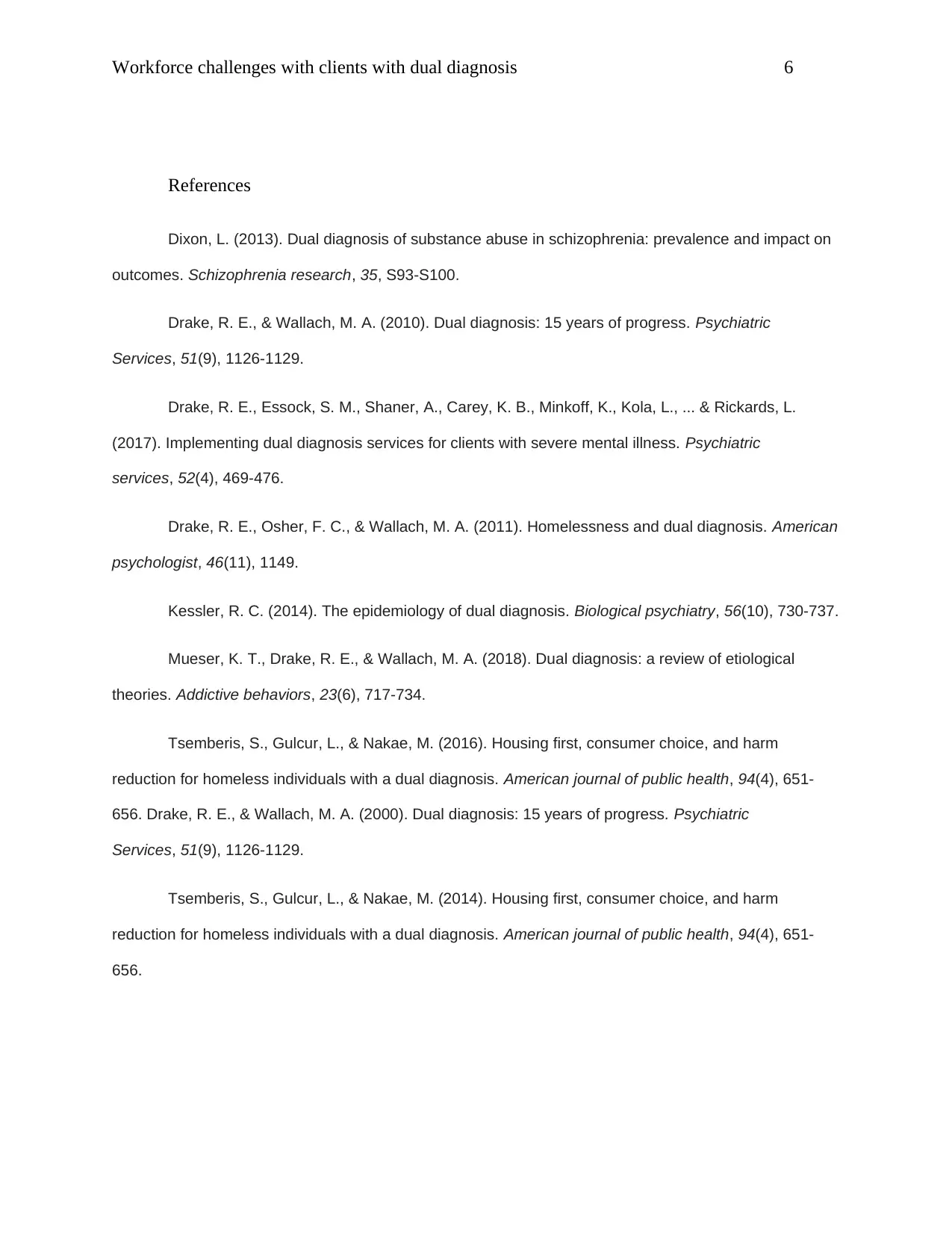Workforce Challenges and Policy for Clients with Dual Diagnosis
VerifiedAdded on 2023/06/03
|6
|1479
|322
Essay
AI Summary
This essay addresses the workforce challenges associated with clients who have a dual diagnosis, encompassing both psychiatric disorders and substance use disorders. The paper highlights the complexities of providing care and treatment, including the increased risks of hospitalization and suicide. It identifies the lack of clear regulatory policies as a primary challenge, leading to potential issues in rehabilitation services. The essay suggests policy recommendations such as the need for skilled professionals, adequate equipment, education programs, and public awareness campaigns, particularly regarding the use of naloxone. It emphasizes the need for networking among treatment providers, resource directories, and staff training to improve the quality of care. The conclusion stresses the importance of stakeholder collaboration, policy formulation, and public awareness in overcoming these challenges and improving outcomes for individuals with dual diagnoses.

Running Head: Workforce challenges with clients with dual diagnosis 1
Workforce challenges with clients with dual diagnosis
Name
Date
Workforce challenges with clients with dual diagnosis
Name
Date
Paraphrase This Document
Need a fresh take? Get an instant paraphrase of this document with our AI Paraphraser

Workforce challenges with clients with dual diagnosis 2
Workforce challenges with clients with dual diagnosis
Dual diagnosis is practice used to treat who suffer from both psychiatric and addiction
disorder. Supporting patients with mental problems and substance use such as opioids is a great
challenge facing metal health service (Tsemberis,2014). Its complexity makes care, and
treatment services more difficult posing the client with high risk of being hospitalized and
sometimes to suicide. This paper tries to explain the difference challenges that face clients with
dual diagnosis and policies which can be implemented to curb them.
One on the main challenges related to this issue, is lack of clear regulatory policy that
monitor the rehabilitation services to these clients. Clients with these problem are entitled to high
quality, integrated care that is patient focused. Some of these rehabilitation homes fail to offer
this type of services posing the clients to more challenges. Research show that some of these
substance that are misused by the clients are addictive and the patients may find themselves
looking for the substances to use instead of seeking medical attention. This is a challenge and a
policy should be formulated to ensure that the opiods drugs are only accessed by patient with
doctor’s prescription.
In order to manage these challenges and bring about change the following policies should
be enacted and well-drawn procedure given on how to implement them. There should be
adequate skilled professionals in the rehabilitation centers and adequate equipment. Other
include education programs and training practices of the personals supporting these patients.
Another practice of implementing the practices that can curb the problem is creating awareness
Workforce challenges with clients with dual diagnosis
Dual diagnosis is practice used to treat who suffer from both psychiatric and addiction
disorder. Supporting patients with mental problems and substance use such as opioids is a great
challenge facing metal health service (Tsemberis,2014). Its complexity makes care, and
treatment services more difficult posing the client with high risk of being hospitalized and
sometimes to suicide. This paper tries to explain the difference challenges that face clients with
dual diagnosis and policies which can be implemented to curb them.
One on the main challenges related to this issue, is lack of clear regulatory policy that
monitor the rehabilitation services to these clients. Clients with these problem are entitled to high
quality, integrated care that is patient focused. Some of these rehabilitation homes fail to offer
this type of services posing the clients to more challenges. Research show that some of these
substance that are misused by the clients are addictive and the patients may find themselves
looking for the substances to use instead of seeking medical attention. This is a challenge and a
policy should be formulated to ensure that the opiods drugs are only accessed by patient with
doctor’s prescription.
In order to manage these challenges and bring about change the following policies should
be enacted and well-drawn procedure given on how to implement them. There should be
adequate skilled professionals in the rehabilitation centers and adequate equipment. Other
include education programs and training practices of the personals supporting these patients.
Another practice of implementing the practices that can curb the problem is creating awareness

Workforce challenges with clients with dual diagnosis 3
Different studies have been carried out on the strategies that can be used to curb the
problem associated with naloxone. Some of these include creating awareness of the general
public. Research findings show that, although naloxone is accepted globally as a method used to
reverse the effects of opioids overdose, a good number of people are not aware (Drake, 2017).
The different study recommends that a worldwide campaign should be carried out in different
countries to let make awareness of this medicine. By doing this, more lives will be saved from
clients with dual diagnosis.
One of the initiatives is to come up with is the need of education program. Various
treatment providers have different policies on how they admit patients with dual diagnoses
medication and the way in which medication is monitored and supplied. The way in which
physicians are used also differs on how they are integrated with the program. There is a need for
organizations for networking to enable the sharing of information since providers of the same
community does not work on isolation. It’s important to have a resource directory which
contains various modalities such as outpatient treatment, day treatment and care home which
should be available to the community (Tsemberis, 2016). There exists a gulf between mental
disorder health and another treatment system which has greatly heightened case managers need
to ask questions to determine if a given resource has the required expertise.
Training is another factor that determines the effectiveness of the efforts of treatment.
Staffs and medical providers in this sector of mental disorder are trained on how to handle their
patients. Staffs serving these clients should be equipped with the necessary skill to ensure that
the patient gets the best services. There is also the need for incorporating technology into this
matter (Drake,2011).
Different studies have been carried out on the strategies that can be used to curb the
problem associated with naloxone. Some of these include creating awareness of the general
public. Research findings show that, although naloxone is accepted globally as a method used to
reverse the effects of opioids overdose, a good number of people are not aware (Drake, 2017).
The different study recommends that a worldwide campaign should be carried out in different
countries to let make awareness of this medicine. By doing this, more lives will be saved from
clients with dual diagnosis.
One of the initiatives is to come up with is the need of education program. Various
treatment providers have different policies on how they admit patients with dual diagnoses
medication and the way in which medication is monitored and supplied. The way in which
physicians are used also differs on how they are integrated with the program. There is a need for
organizations for networking to enable the sharing of information since providers of the same
community does not work on isolation. It’s important to have a resource directory which
contains various modalities such as outpatient treatment, day treatment and care home which
should be available to the community (Tsemberis, 2016). There exists a gulf between mental
disorder health and another treatment system which has greatly heightened case managers need
to ask questions to determine if a given resource has the required expertise.
Training is another factor that determines the effectiveness of the efforts of treatment.
Staffs and medical providers in this sector of mental disorder are trained on how to handle their
patients. Staffs serving these clients should be equipped with the necessary skill to ensure that
the patient gets the best services. There is also the need for incorporating technology into this
matter (Drake,2011).
⊘ This is a preview!⊘
Do you want full access?
Subscribe today to unlock all pages.

Trusted by 1+ million students worldwide

Workforce challenges with clients with dual diagnosis 4
There is a need for a forum to develop policies and procedure. The problem of dual
diagnosis patient needs support and efforts from state, national and federal levels to address
issues concerning this issues. Policymakers should consider this as a concern should need
immediate consideration. A good plan should be formulated on barriers on this issue of dual
diagnoses disorder (Drake,2010). A system needs to be put in place to address the needs of
dually diagnosed clients in order to ensure that they get a well sustainable level of health care.
There are different intervention approaches used in different countries on the issue of
dual diagnosis. These approaches are related to various advantages and disadvantages to both
clients and therapist. For example, use of OPHI was viewed of great importance in the way it
responded to the patient’s unique characteristic and need. In construct, it was some clients felt
that the information asked was too sensitive and personal to share thus required trust issues to be
developed. Another interactive type is the provision of services which are client center. One of
its advantage viewed by the client is the therapist behaviors and personality on how to relate to
the clients. The major disadvantage with this approach is that some therapist lacks good
communication skills and this acts as a barrier to communication and feedback (Kessler, 2014).
From the research findings above, it is evident that proper ways of implementing policies
that affect the patient with dual diagnoses are required. All parties involved are required to join
hands to implement and manage changes that will solve the challenges with dual diagnosis. This
includes proper training of staffs handling dual diagnosis client. This will ensure they are
handled with care and get good services. Another recommendation from the study is that there is
a need for policy formulation a procedure related to dual diagnoses (Dixon, 2013). The
policymakers have a task to make sure these policies are formulated and implemented. Another
There is a need for a forum to develop policies and procedure. The problem of dual
diagnosis patient needs support and efforts from state, national and federal levels to address
issues concerning this issues. Policymakers should consider this as a concern should need
immediate consideration. A good plan should be formulated on barriers on this issue of dual
diagnoses disorder (Drake,2010). A system needs to be put in place to address the needs of
dually diagnosed clients in order to ensure that they get a well sustainable level of health care.
There are different intervention approaches used in different countries on the issue of
dual diagnosis. These approaches are related to various advantages and disadvantages to both
clients and therapist. For example, use of OPHI was viewed of great importance in the way it
responded to the patient’s unique characteristic and need. In construct, it was some clients felt
that the information asked was too sensitive and personal to share thus required trust issues to be
developed. Another interactive type is the provision of services which are client center. One of
its advantage viewed by the client is the therapist behaviors and personality on how to relate to
the clients. The major disadvantage with this approach is that some therapist lacks good
communication skills and this acts as a barrier to communication and feedback (Kessler, 2014).
From the research findings above, it is evident that proper ways of implementing policies
that affect the patient with dual diagnoses are required. All parties involved are required to join
hands to implement and manage changes that will solve the challenges with dual diagnosis. This
includes proper training of staffs handling dual diagnosis client. This will ensure they are
handled with care and get good services. Another recommendation from the study is that there is
a need for policy formulation a procedure related to dual diagnoses (Dixon, 2013). The
policymakers have a task to make sure these policies are formulated and implemented. Another
Paraphrase This Document
Need a fresh take? Get an instant paraphrase of this document with our AI Paraphraser

Workforce challenges with clients with dual diagnosis 5
recommendation is the need for public awareness of the causes of dual mental disorders and
ways of overcoming them.
In conclusion, we find that there are various types of challenges with patients with dual
diagnoses. This calls for all stakeholder to join hand to curb these challenges. Proper policies and
procedure are required to handle this issue. Various practices as a creating awareness, training
and education program are also ways in which these challenges can be overcome. There, it is the
role of the general public to know their role in curbing these challenges.
recommendation is the need for public awareness of the causes of dual mental disorders and
ways of overcoming them.
In conclusion, we find that there are various types of challenges with patients with dual
diagnoses. This calls for all stakeholder to join hand to curb these challenges. Proper policies and
procedure are required to handle this issue. Various practices as a creating awareness, training
and education program are also ways in which these challenges can be overcome. There, it is the
role of the general public to know their role in curbing these challenges.

Workforce challenges with clients with dual diagnosis 6
References
Dixon, L. (2013). Dual diagnosis of substance abuse in schizophrenia: prevalence and impact on
outcomes. Schizophrenia research, 35, S93-S100.
Drake, R. E., & Wallach, M. A. (2010). Dual diagnosis: 15 years of progress. Psychiatric
Services, 51(9), 1126-1129.
Drake, R. E., Essock, S. M., Shaner, A., Carey, K. B., Minkoff, K., Kola, L., ... & Rickards, L.
(2017). Implementing dual diagnosis services for clients with severe mental illness. Psychiatric
services, 52(4), 469-476.
Drake, R. E., Osher, F. C., & Wallach, M. A. (2011). Homelessness and dual diagnosis. American
psychologist, 46(11), 1149.
Kessler, R. C. (2014). The epidemiology of dual diagnosis. Biological psychiatry, 56(10), 730-737.
Mueser, K. T., Drake, R. E., & Wallach, M. A. (2018). Dual diagnosis: a review of etiological
theories. Addictive behaviors, 23(6), 717-734.
Tsemberis, S., Gulcur, L., & Nakae, M. (2016). Housing first, consumer choice, and harm
reduction for homeless individuals with a dual diagnosis. American journal of public health, 94(4), 651-
656. Drake, R. E., & Wallach, M. A. (2000). Dual diagnosis: 15 years of progress. Psychiatric
Services, 51(9), 1126-1129.
Tsemberis, S., Gulcur, L., & Nakae, M. (2014). Housing first, consumer choice, and harm
reduction for homeless individuals with a dual diagnosis. American journal of public health, 94(4), 651-
656.
References
Dixon, L. (2013). Dual diagnosis of substance abuse in schizophrenia: prevalence and impact on
outcomes. Schizophrenia research, 35, S93-S100.
Drake, R. E., & Wallach, M. A. (2010). Dual diagnosis: 15 years of progress. Psychiatric
Services, 51(9), 1126-1129.
Drake, R. E., Essock, S. M., Shaner, A., Carey, K. B., Minkoff, K., Kola, L., ... & Rickards, L.
(2017). Implementing dual diagnosis services for clients with severe mental illness. Psychiatric
services, 52(4), 469-476.
Drake, R. E., Osher, F. C., & Wallach, M. A. (2011). Homelessness and dual diagnosis. American
psychologist, 46(11), 1149.
Kessler, R. C. (2014). The epidemiology of dual diagnosis. Biological psychiatry, 56(10), 730-737.
Mueser, K. T., Drake, R. E., & Wallach, M. A. (2018). Dual diagnosis: a review of etiological
theories. Addictive behaviors, 23(6), 717-734.
Tsemberis, S., Gulcur, L., & Nakae, M. (2016). Housing first, consumer choice, and harm
reduction for homeless individuals with a dual diagnosis. American journal of public health, 94(4), 651-
656. Drake, R. E., & Wallach, M. A. (2000). Dual diagnosis: 15 years of progress. Psychiatric
Services, 51(9), 1126-1129.
Tsemberis, S., Gulcur, L., & Nakae, M. (2014). Housing first, consumer choice, and harm
reduction for homeless individuals with a dual diagnosis. American journal of public health, 94(4), 651-
656.
⊘ This is a preview!⊘
Do you want full access?
Subscribe today to unlock all pages.

Trusted by 1+ million students worldwide
1 out of 6
Related Documents
Your All-in-One AI-Powered Toolkit for Academic Success.
+13062052269
info@desklib.com
Available 24*7 on WhatsApp / Email
![[object Object]](/_next/static/media/star-bottom.7253800d.svg)
Unlock your academic potential
Copyright © 2020–2025 A2Z Services. All Rights Reserved. Developed and managed by ZUCOL.





